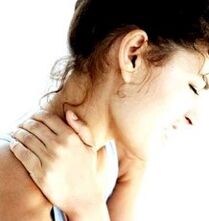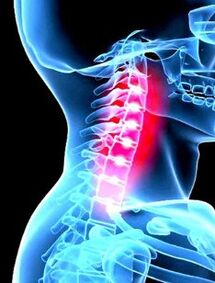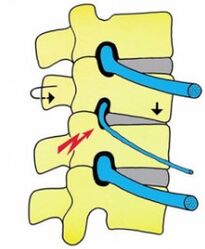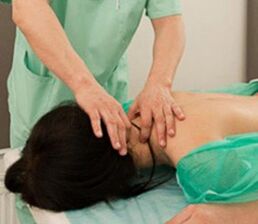
The main causes of the diseaseIt has been established that osteochondrosis is a disease that "becomes young". Now, this disease is increasingly found in people aged 18 to 30, while cases of 40 previously were considered the norm. The reasons for this can be distinguished by the following:violation of the posture, presence of vertebral curvature as a function of the type of scoliosis, lordosis or cyphosis;overweight, obesity;back injuries;Metabolic disorder, low metabolism;hard physical work;Hypodynamia, sedentary lifestyle;low physical training;Nervous exhaustion, stress;non-compliance with hygiene training in athletes;strong termination of training;infectious diseases;body hypothermia.Osteochondrosis, in substance, is a consequence of muscle clamps, muscle spasms in the end the mobility of the cervical column, disturb the circulation of blood, aggravates the blood supply of bone and muscular tissues, which causes the development of dystrophic processes in discs and vertebrae, narrowing of the interverters. Consequently - the rushed nerve roots and the loss of sensitivity. Cervical osteochondosis symptomsCervical osteochondosis has a variety of symptoms. However, for the most part, manifesting osteochondrosis affects the circulatory system. In the cervical region, there are many blood vessels that nourish the brain intensively. Consequently, the danger of osteochondrosis is associated with poor supply of the organs of the head, especially of the brain, of the blood. The signs of osteochondrosis of the cervical column will be expressed is affected by the defeated segment. Therefore, the following signs of cervical osteochondosis are distinguished:root syndromes;cardinal syndrome;
Irritated-reflexes syndromes;vertebral artery syndrome;The compression of the spinal cord.What are the symptoms of cervical osteochondosis in case is characteristic? Medicine ruin syndrome is called a cervical radiculitis, it occurs due to nerve pinching in the neck. The pain arises on the neck, descend into the sections of the shoulder blades, can be lower on the shoulder and the forearm, to the fingers. The characteristic signs of cervical osteochondosis in this case are the experience of tingling, the senses of burns, pastoicity, numbness of the hands, the forearm or the fingers. The symptoms of osteochondrosis in the cervical region will have different, the segment of which has suffered damage to the disease will affect their difference. In the event that the central nerve and its roots are affected, the passose will be average, index, as well as the thumb. If the roots of the nerve of the shoulder were affected, the passose will be a finger and an annular. Osteochondrosis of the cervical column, the symptoms will have the following syndrome as an irritating reflex. The main characteristic will be the presence of acute, intense and burning pain in the cervical and consumer region or in the neck itself. Pain tends to increase during movement or charges, it is particularly acute after a static state. For example, after sleep, with inaccurate turns of the head, after sleep. Cervical osteochondosis of symptoms has similar, because with the development of this syndrome, the pain is transmitted to the chest. It is diagnosed in cases where the damage area is not limited to the neck, but goes to the breast segments. Symptoms show a greater spectrum of cervical osteochondosis, the most main of them is a violation of the work of the internal organs.Vertebral artery syndrome- The exacerbation of cervical osteochondosis, the symptoms are extremely intensively and consist of serious and burning pain. The pulsating pain in the temples, the presence of severe migraines, which particularly surprise the parietal part, the back of the head and the fronte region are characteristic. The pain is chronic, constant, but sometimes they record cases of paroxysmal pain. The exacerbation of osteochondrosis of the cervical column expresses symptoms in the form of increasing pain. This happens after being in uncomfortable poses, with sudden movements, a serious physical effort. The exacerbation threatens hearing disorders - a vestibular disorder, feeling noise in the ears, as well as a decrease in auditory acuity. Vision problems are not uncommon. Osteochondrosis of cervical spy symptoms with cardinal syndrome. Cardinal syndrome is characterized by a severe chest. It is difficult to identify primary disease - osteochondrosis. Diagnostics "osteochondrosis in the cervical region" is often done in a timely manner, as they try to diagnose angina and treat it, this threatens the transition of osteochondosis in chronic form. 
The angina phenomenon of angina is caused by pressing the spine in the lower segments of the cervical region, which finds a reflex response. Cardinal syndrome can manifest itself in cases where the roots of the chest or diaphragmatic nerve are irritated. Osteochondrosis of the cervical column symptoms with cardinal syndrome can manifest itself in the form of tachycardia, extrasystole. There are frequent cases when osteochondrosis in the cervical region and hypertension also takes place jointly. Likewise, symptoms of cervical osteochondosis are symptoms, its treatment does not always come out in a timely manner, as doctors initially diagnose cardiovascular disease and not osteochondrosis.Cervical osteochondosis symptoms and treatmentsA certain syndrome is diagnosed from the predominance of certain symptoms, the treatment is already carried out on the basis of this. The treatment is carried out in two ways: either radical, involving surgery or a conservative method. In these cases, if conservative treatment has not given results, an indication of the operation is prescribed. Osteochondrosis in the cervical region is eliminated by the following methods:Manual therapy;massages, physiotherapeutic procedures;reflexotherapy - acupuncture;medical treatment, pills;water procedures;Folk treatment methods;LFK lessons, as well as well-being gymnastics.Cervical osteochondrosis symptoms Treatment of tabletAs a rule, drug treatment is prescribed in cases where symptoms include the presence of serious pain. In fact, the pills are not a panacea for the cause of pain - osteochondrosis itself. The tablets are also prescribed if the temperature of osteochondrosis of the cervical column has increased. This symptom indicates that the presence of inflammatory processes in the body, inflammation of tissues and nerves should be eliminated. 
Cervical osteochondrosis, symptoms, treatment and gymnasticsAn effective and affordable treatment method is considered a complex for exercise therapy and gymnastics exercises. The exercises aim to increase the flexibility of the cervical column, increasing the interl distance, strengthening the muscle corset which would protect the spine from injury and damage. In addition, gymnastics and exercises very effectively establish the functioning of the circulatory system, which not only promotes bone tissue, but also allows us to normalize blood flow to the brain. The main thing is to perform exercises under the supervision of a doctor.Cervical osteochondrosis, symptoms and treatment of surgeryIn the event that conservative treatment has not given results, the operation is prescribed. It provides for the elimination of processes, arches and ligaments, as well as the elimination of hernias that fell into the spine canal. After this procedure, cases of total instability in the cervical region are not uncommon. After surgery, a special support collar is prescribed to the patient, which stabilizes a weak neck and temporarily supports it.As a general rule, if you diagnose the disease in a timely manner, keep the doctor's strict recommendations and you engage in complete conservative therapy, then osteochondrosis is considerably adjusted, in many cases, a complete recovery image is observed.
Cervical osteochondosis symptomsCervical osteochondosis has a variety of symptoms. However, for the most part, manifesting osteochondrosis affects the circulatory system. In the cervical region, there are many blood vessels that nourish the brain intensively. Consequently, the danger of osteochondrosis is associated with poor supply of the organs of the head, especially of the brain, of the blood. The signs of osteochondrosis of the cervical column will be expressed is affected by the defeated segment. Therefore, the following signs of cervical osteochondosis are distinguished:root syndromes;cardinal syndrome;
Irritated-reflexes syndromes;vertebral artery syndrome;The compression of the spinal cord.What are the symptoms of cervical osteochondosis in case is characteristic? Medicine ruin syndrome is called a cervical radiculitis, it occurs due to nerve pinching in the neck. The pain arises on the neck, descend into the sections of the shoulder blades, can be lower on the shoulder and the forearm, to the fingers. The characteristic signs of cervical osteochondosis in this case are the experience of tingling, the senses of burns, pastoicity, numbness of the hands, the forearm or the fingers. The symptoms of osteochondrosis in the cervical region will have different, the segment of which has suffered damage to the disease will affect their difference. In the event that the central nerve and its roots are affected, the passose will be average, index, as well as the thumb. If the roots of the nerve of the shoulder were affected, the passose will be a finger and an annular. Osteochondrosis of the cervical column, the symptoms will have the following syndrome as an irritating reflex. The main characteristic will be the presence of acute, intense and burning pain in the cervical and consumer region or in the neck itself. Pain tends to increase during movement or charges, it is particularly acute after a static state. For example, after sleep, with inaccurate turns of the head, after sleep. Cervical osteochondosis of symptoms has similar, because with the development of this syndrome, the pain is transmitted to the chest. It is diagnosed in cases where the damage area is not limited to the neck, but goes to the breast segments. Symptoms show a greater spectrum of cervical osteochondosis, the most main of them is a violation of the work of the internal organs.Vertebral artery syndrome- The exacerbation of cervical osteochondosis, the symptoms are extremely intensively and consist of serious and burning pain. The pulsating pain in the temples, the presence of severe migraines, which particularly surprise the parietal part, the back of the head and the fronte region are characteristic. The pain is chronic, constant, but sometimes they record cases of paroxysmal pain. The exacerbation of osteochondrosis of the cervical column expresses symptoms in the form of increasing pain. This happens after being in uncomfortable poses, with sudden movements, a serious physical effort. The exacerbation threatens hearing disorders - a vestibular disorder, feeling noise in the ears, as well as a decrease in auditory acuity. Vision problems are not uncommon. Osteochondrosis of cervical spy symptoms with cardinal syndrome. Cardinal syndrome is characterized by a severe chest. It is difficult to identify primary disease - osteochondrosis. Diagnostics "osteochondrosis in the cervical region" is often done in a timely manner, as they try to diagnose angina and treat it, this threatens the transition of osteochondosis in chronic form. 
The angina phenomenon of angina is caused by pressing the spine in the lower segments of the cervical region, which finds a reflex response. Cardinal syndrome can manifest itself in cases where the roots of the chest or diaphragmatic nerve are irritated. Osteochondrosis of the cervical column symptoms with cardinal syndrome can manifest itself in the form of tachycardia, extrasystole. There are frequent cases when osteochondrosis in the cervical region and hypertension also takes place jointly. Likewise, symptoms of cervical osteochondosis are symptoms, its treatment does not always come out in a timely manner, as doctors initially diagnose cardiovascular disease and not osteochondrosis.Cervical osteochondosis symptoms and treatmentsA certain syndrome is diagnosed from the predominance of certain symptoms, the treatment is already carried out on the basis of this. The treatment is carried out in two ways: either radical, involving surgery or a conservative method. In these cases, if conservative treatment has not given results, an indication of the operation is prescribed. Osteochondrosis in the cervical region is eliminated by the following methods:Manual therapy;massages, physiotherapeutic procedures;reflexotherapy - acupuncture;medical treatment, pills;water procedures;Folk treatment methods;LFK lessons, as well as well-being gymnastics.Cervical osteochondrosis symptoms Treatment of tabletAs a rule, drug treatment is prescribed in cases where symptoms include the presence of serious pain. In fact, the pills are not a panacea for the cause of pain - osteochondrosis itself. The tablets are also prescribed if the temperature of osteochondrosis of the cervical column has increased. This symptom indicates that the presence of inflammatory processes in the body, inflammation of tissues and nerves should be eliminated. 
Cervical osteochondrosis, symptoms, treatment and gymnasticsAn effective and affordable treatment method is considered a complex for exercise therapy and gymnastics exercises. The exercises aim to increase the flexibility of the cervical column, increasing the interl distance, strengthening the muscle corset which would protect the spine from injury and damage. In addition, gymnastics and exercises very effectively establish the functioning of the circulatory system, which not only promotes bone tissue, but also allows us to normalize blood flow to the brain. The main thing is to perform exercises under the supervision of a doctor.Cervical osteochondrosis, symptoms and treatment of surgeryIn the event that conservative treatment has not given results, the operation is prescribed. It provides for the elimination of processes, arches and ligaments, as well as the elimination of hernias that fell into the spine canal. After this procedure, cases of total instability in the cervical region are not uncommon. After surgery, a special support collar is prescribed to the patient, which stabilizes a weak neck and temporarily supports it.As a general rule, if you diagnose the disease in a timely manner, keep the doctor's strict recommendations and you engage in complete conservative therapy, then osteochondrosis is considerably adjusted, in many cases, a complete recovery image is observed.


Cervical osteochondosis symptoms and treatmentsA certain syndrome is diagnosed from the predominance of certain symptoms, the treatment is already carried out on the basis of this. The treatment is carried out in two ways: either radical, involving surgery or a conservative method. In these cases, if conservative treatment has not given results, an indication of the operation is prescribed. Osteochondrosis in the cervical region is eliminated by the following methods:Manual therapy;massages, physiotherapeutic procedures;reflexotherapy - acupuncture;medical treatment, pills;water procedures;Folk treatment methods;LFK lessons, as well as well-being gymnastics.Cervical osteochondrosis symptoms Treatment of tabletAs a rule, drug treatment is prescribed in cases where symptoms include the presence of serious pain. In fact, the pills are not a panacea for the cause of pain - osteochondrosis itself. The tablets are also prescribed if the temperature of osteochondrosis of the cervical column has increased. This symptom indicates that the presence of inflammatory processes in the body, inflammation of tissues and nerves should be eliminated. 
Cervical osteochondrosis, symptoms, treatment and gymnasticsAn effective and affordable treatment method is considered a complex for exercise therapy and gymnastics exercises. The exercises aim to increase the flexibility of the cervical column, increasing the interl distance, strengthening the muscle corset which would protect the spine from injury and damage. In addition, gymnastics and exercises very effectively establish the functioning of the circulatory system, which not only promotes bone tissue, but also allows us to normalize blood flow to the brain. The main thing is to perform exercises under the supervision of a doctor.Cervical osteochondrosis, symptoms and treatment of surgeryIn the event that conservative treatment has not given results, the operation is prescribed. It provides for the elimination of processes, arches and ligaments, as well as the elimination of hernias that fell into the spine canal. After this procedure, cases of total instability in the cervical region are not uncommon. After surgery, a special support collar is prescribed to the patient, which stabilizes a weak neck and temporarily supports it.As a general rule, if you diagnose the disease in a timely manner, keep the doctor's strict recommendations and you engage in complete conservative therapy, then osteochondrosis is considerably adjusted, in many cases, a complete recovery image is observed.
Cervical osteochondrosis symptoms Treatment of tabletAs a rule, drug treatment is prescribed in cases where symptoms include the presence of serious pain. In fact, the pills are not a panacea for the cause of pain - osteochondrosis itself. The tablets are also prescribed if the temperature of osteochondrosis of the cervical column has increased. This symptom indicates that the presence of inflammatory processes in the body, inflammation of tissues and nerves should be eliminated. 
Cervical osteochondrosis, symptoms, treatment and gymnasticsAn effective and affordable treatment method is considered a complex for exercise therapy and gymnastics exercises. The exercises aim to increase the flexibility of the cervical column, increasing the interl distance, strengthening the muscle corset which would protect the spine from injury and damage. In addition, gymnastics and exercises very effectively establish the functioning of the circulatory system, which not only promotes bone tissue, but also allows us to normalize blood flow to the brain. The main thing is to perform exercises under the supervision of a doctor.Cervical osteochondrosis, symptoms and treatment of surgeryIn the event that conservative treatment has not given results, the operation is prescribed. It provides for the elimination of processes, arches and ligaments, as well as the elimination of hernias that fell into the spine canal. After this procedure, cases of total instability in the cervical region are not uncommon. After surgery, a special support collar is prescribed to the patient, which stabilizes a weak neck and temporarily supports it.As a general rule, if you diagnose the disease in a timely manner, keep the doctor's strict recommendations and you engage in complete conservative therapy, then osteochondrosis is considerably adjusted, in many cases, a complete recovery image is observed.


























